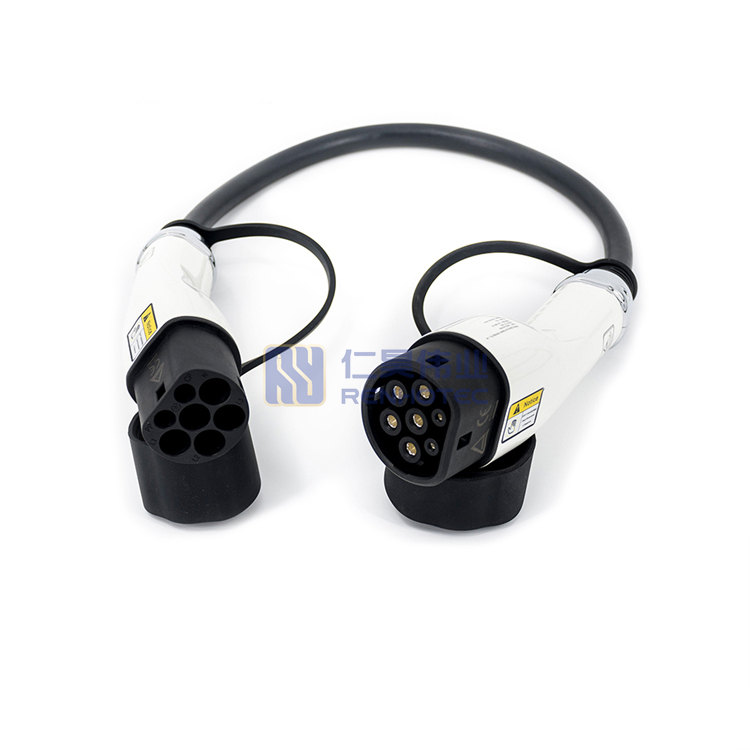Angesichts der rasanten Entwicklung der weltweiten Elektrofahrzeugindustrie beschleunigen verschiedene Länder den Bau von Ladesäulen für Elektrofahrzeuge. Allerdings variieren die Typen der Ladestecker von Land zu Land, was sich in gewissem Maße auf die Bequemlichkeit des Aufladens von Elektrofahrzeugen auswirkt.
Derzeit wird in Nordamerika hauptsächlich die Norm SAE J1772, in Europa die Norm IEC 62196-1,2,3, in China die Norm GB/T 20234.1,2,3-2011 und in Japan die Norm CHAdeMO verwendet. Abbildung 1 zeigt die Arten von Ladesteckern für Elektrofahrzeuge weltweit.
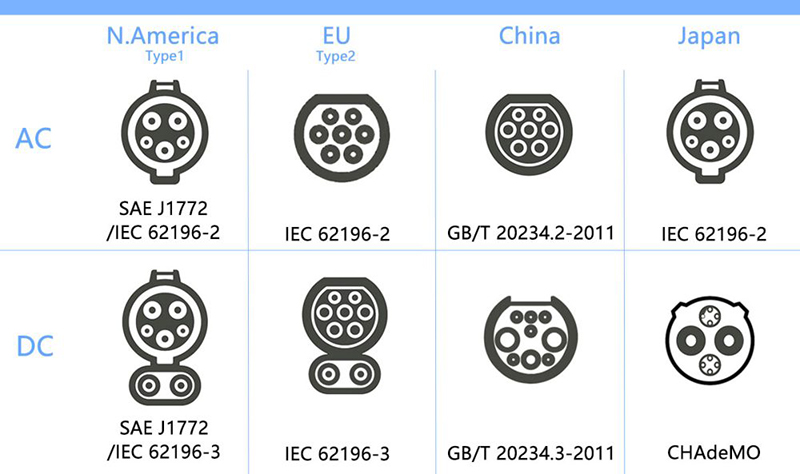
SAE J1772-Norm
SAE J1772 ist eine nordamerikanische Norm für elektrische Steckverbinder für Elektrofahrzeuge, die von der SAE International gepflegt wird und den offiziellen Titel SAE Surface Vehicle Recommended Practice J1772, SAE Electric Vehicle Conductive Charge Coupler“ trägt.
Der SAE J1772 Standard-Wechselstrom-Ladestecker ist in Abbildung 2 dargestellt.
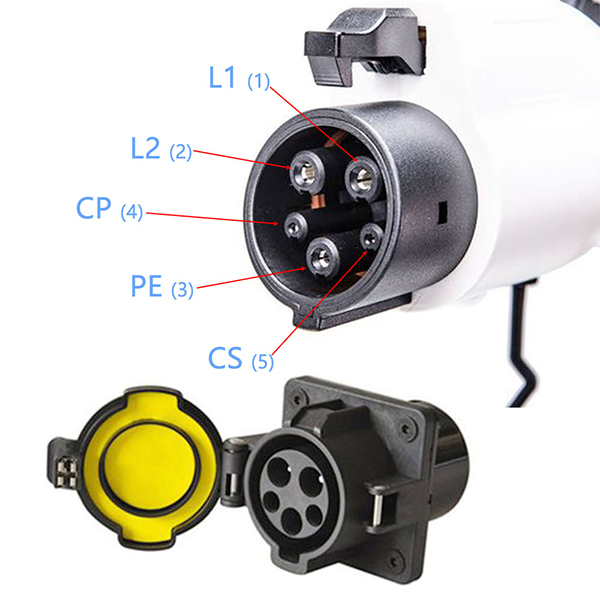
Die Funktion der einzelnen Kontakte ist in Tabelle 1 dargestellt. für die einphasige AC-Ladung, ihre Spannung und ihr maximaler Strom sind in Tabelle 2 angegeben.
| Table 1: Function of each PIN according to SAE J1772 standard | ||
|---|---|---|
| PIN | Function | Primary AC and secondary AC |
| 1 | Mains 1 | Required |
| 2 | Mains 2 | Required |
| 3 | Ground | Required |
| 4 | Control pilot | Required |
| 5 | Connection switch | Required |
| Table 2: Primary AC and secondary AC | |||
|---|---|---|---|
| Charging Method | Supply Voltage (V) | Maximum Current (A) | Branch Circuit Breaker Rating (A) |
| Primary AC | 120V AC, Single-phase | 12A | 15A (minimum) |
| 120V AC, Single-phase | 16A | 20A | |
| Secondary AC | 208~240V, Single-phase | ≤80A | According to NEC 625 |
IEC 62196-1,2,3 Norm
Typ 1
IEC 62196 ist eine internationale Norm für elektrische Steckverbinder und Lademodi für Elektrofahrzeuge und wird von der Internationalen Elektrotechnischen Kommission (IEC) gepflegt.
Die Kontaktdefinition des IEC 62196-Standard-Ladesteckers Typ 1 ist dieselbe wie die der SAE J1772-Standard-AC-Ladeschnittstelle, wie in Abbildung 2 dargestellt.
| Table 3: Maximum voltage and current for each contact according to IEC 62196 Type 1 | ||
|---|---|---|
| PIN ③ | AC | Functions ① |
| 1 | 250V 32A ② | L1 (mains 1) |
| 2 | 250V 32A | L2 (mains 2) / N (neutral) |
| 3 | Rated for fault | PE (ground / earth) |
| 4 | 30V 2A | CP (Control pilot) |
| 5 | 30V 2A | CS (Connection switch) |
| ① For contacts 4 and 5, environmental conditions may demand larger conductor cross-sections. ② In the following countries, the branch circuit overcurrent protection is based upon 125% of the device rating: USA. ③ Positon number does not refer to the location and/or identification of the contact in the accessory. | ||
Typ 2
Die Kontaktdefinition des Ladesteckers Typ 2 der Norm IEC 62196 ist in Abbildung 3 dargestellt.
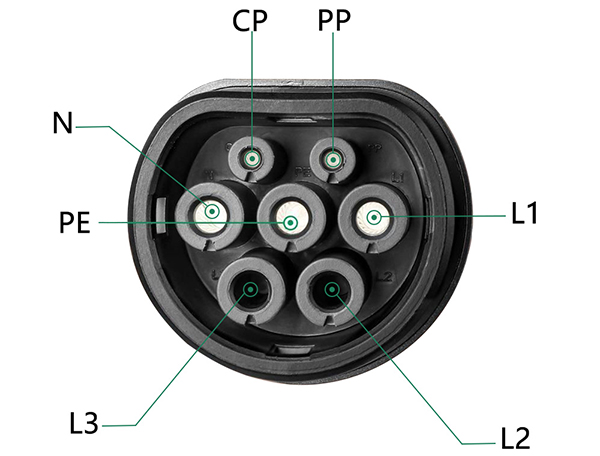
Ladestromanschlüsse: Leitung (L1), Leitung (L2), Leitung (L3), Neutralleiter (N) und Schutzerde (PE).
Signalanschlüsse: Steuerpilot (CP) und Naherungspilot (PP).
Die maximale Spannung und der maximale Strom des IEC 62196-Standard-Ladesteckers bei dreiphasigem und einphasigem Strom sind in Tabelle 3 angegeben.
| Table 4: Maximum voltage and current for each PIN according to IEC 62196 in three-phase power and single-phase power | ||||||
|---|---|---|---|---|---|---|
| PIN ⑥ | Three phase | Single phase | Functions | |||
| Umax | Imax ① | Imax ① | ||||
| V a.c. | A | A | ||||
| Type 2 | Type 3 | Type 2 ② | Type 3 | |||
| 1 | 500 | 63 | 32 | 70 | 32 | L1 (mains 1) ② |
| 2 | 500 | 63 | 32 | – ③ | – ③ | L2 (mains 2) |
| 3 | 500 | 63 | 32 | – ③ | – ③ | L3 (mains 3) |
| 4 | 500 | 63 | 32 | 70 | 32 | N (neutral) ②③ |
| 5 | — | Rated for fault | PE (ground / earth) | |||
| 6 | 30 | 2 | CP (Control pilot) | |||
| 7 | 30 | 2 | PP (Proximity) ④ or CS (Connection switch) ④ | |||
| ① In the following countries, the branch circuit overcurrent protection is based upon 125% of the device rating: USA. ② For single phase charging contacts 1 and 4 shall be used. ③ Unused contacts need not to be installed. Not provided for standard sheets 2-llla and 2-lllb. ④ Not provided for standard sheet 2-llla. ⑤ For single phase system supply phase to phase this contact can be used for L2 (mains 2). ⑥ Position number does not refer to the location and/or identification of the contact in the accessory. | ||||||
CHAdeMO-Norm
CHAdeMO wurde von der Tokyo Electric Power Company, Nissan, Mitsubishi und Fuji Heavy Industries gegründet. Toyota trat später als fünftes Mitglied der Geschäftsführung bei. Drei dieser Unternehmen haben Elektrofahrzeuge entwickelt, die den TEPCO DC-Stecker für die Schnellladung verwenden.
Die Kontaktdefinition des Ladesteckers des CHAdeMO-Standards ist in Tabelle 5 zu sehen, während Abbildung 4 den Zeitschaltkreis des CHAdeMO zeigt.
| Table 5: Function of each PIN according to CHAdeMO Standard | |
|---|---|
| PIN | Functions |
| 1 | Ground |
| 2 | Charge sequence signal |
| 3 | Not connected |
| 4 | Charging enable |
| 5 | DC power |
| 6 | DC power |
| 7 | Connector proximity detection |
| 8 | CAN bus |
| 9 | CAN bus |
| 10 | Charge sequence signal |
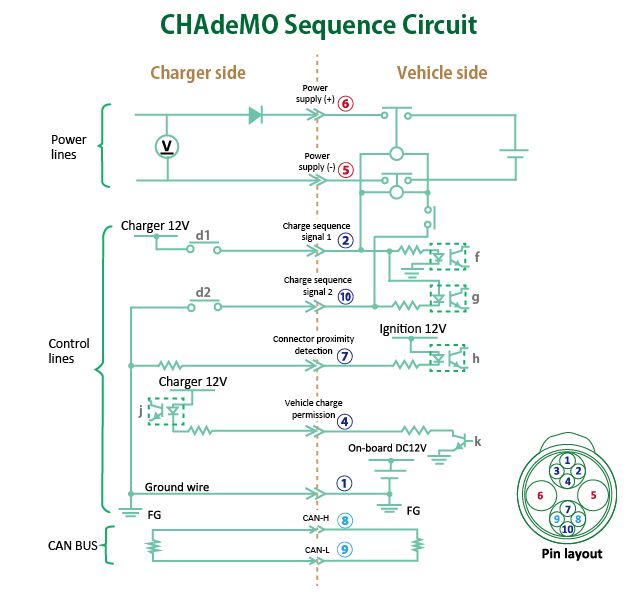
Der CHAdeMO-Standard kann eine Hochspannungs-Gleichstromleistung von bis zu 62,5 kW abgeben. Abbildung 5 zeigt die CHAdeMO-Standard-EV-Ladestecker.
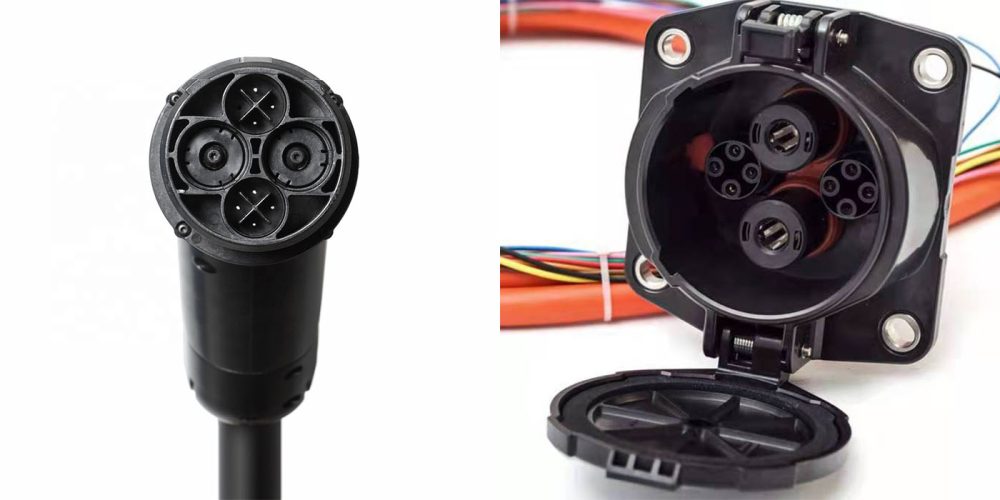
GB/T 20234.1,2,3-2011 Norm
Die Norm GB/T 20234.1,2,3-2011 hat einen AC-Ladestecker (siehe Abbildung 6), einen DC-Ladestecker (siehe Abbildung 7) und eine maximale Spannung und Stromstärke sowie einen Isolationsgrad (siehe Abbildung 7). Das DC-Laden von GB verwendet ebenfalls CAN-Kommunikation.
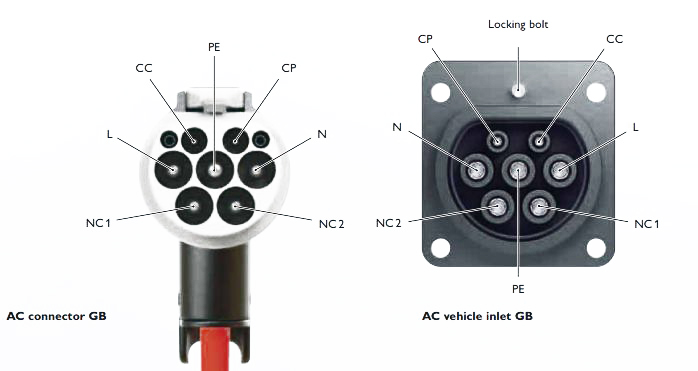
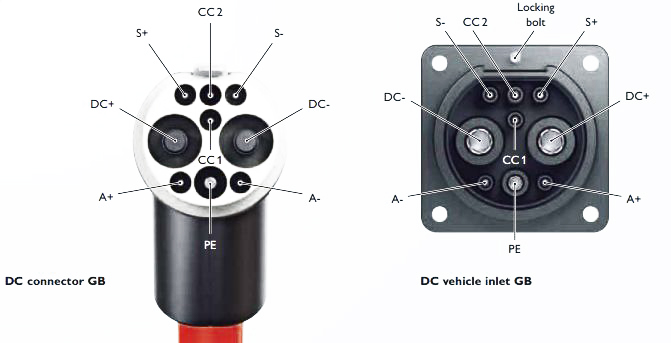
| Table 6: AC and DC charging system according to GB standard | ||
|---|---|---|
| Parameter | AC | DC |
| GB standard | ||
| Nominal voltage | Up to 440 V AC | Up to 750 V DC |
| Nominal current | Up to 32 A | Up to 250 A |
| Standard | GB/T Part 2 | GB/T Part 3 |
| IP protection when plugged in | IP55 | IP55 |
| IP protection with protective cap | IP54 | IP54 |
Kombiniertes Ladesystem (CCS) Standard
Das Combined Charging System ist eine Schnelllademethode für batteriebetriebene Elektrofahrzeuge, die Hochspannungs-Gleichstrom über einen speziellen elektrischen Anschluss liefert, der vom SAE J1772 (IEC Typ 1) oder IEC Typ 2 Anschluss abgeleitet ist. Da der Stecker eine Kombination aus einem AC-Stecker und einer DC-Option ist, wird der resultierende Stecker auch Combo Coupler genannt und die Variante mit Typ 2 als Combo2 abgekürzt.
Die acht großen amerikanischen und deutschen Hersteller, Ford, GM, Chrysler, Audi, BMW, Mercedes-Benz, Volkswagen und Porsche, haben 2012 das „Joint Charging System“ veröffentlicht. Alle aktuellen Ladeschnittstellen sind vereinheitlicht, sodass vier Modi – einphasiges AC-Laden, schnelles dreiphasiges AC-Laden, DC-Laden zu Hause und superschnelles DC-Laden – über eine Schnittstelle möglich sind.
Der Ladestecker des kombinierten Typs nach SAE J1772-Standard ist in Abbildung 8 dargestellt. Abbildung 9 zeigt den kombinierten Ladestecker mit Aufladung nach der Norm IEC 62196. Abbildung 10 zeigt die schematische Darstellung der kombinierten Lade- und Leistungsinformationen.
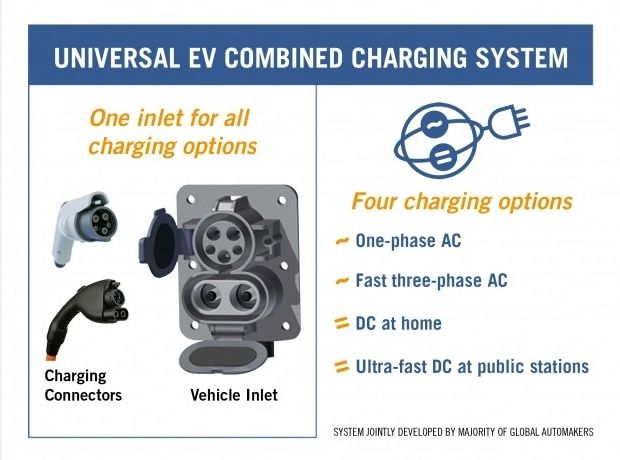
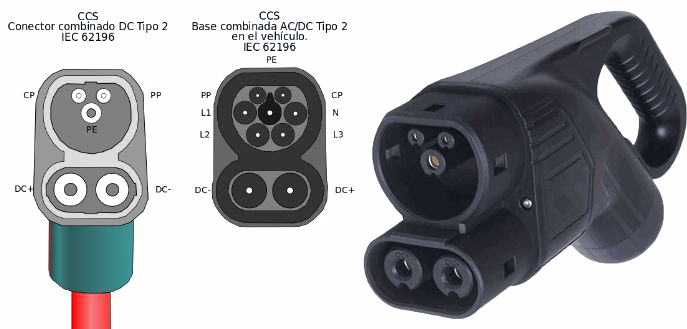
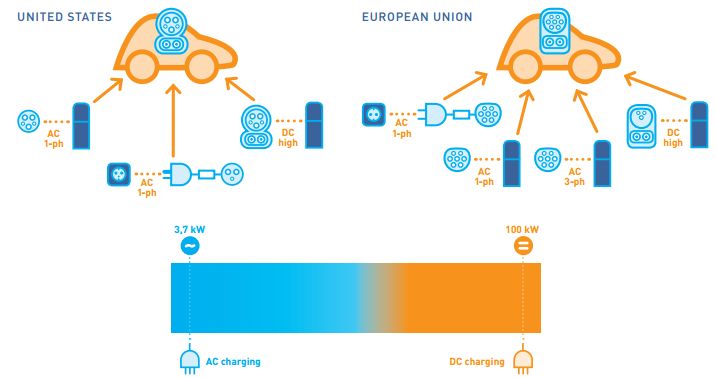
Das Kommunikationsprotokoll für das kombinierte Laden verwendet die Kommunikation über Stromträger, PLC (Power Line Communication). GB/T und CHAdeMO verwenden hingegen die CAN-Kommunikation.
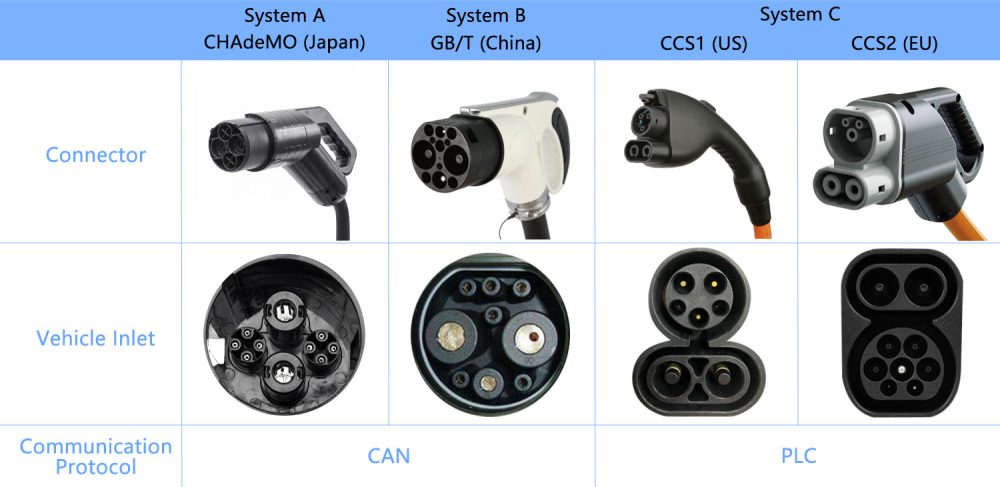
Zusammenfassung
CCS verfügt über AC- und DC-Ladefunktionen mit großer Vielseitigkeit und hoher Leistung, hat aber eine komplexe Schnittstelle und problematische Kompatibilität. GB/T ist der nationale Standard Chinas und an die lokalen Branchen angepasst, hat aber keine internationale Anwendbarkeit. CHAdeMO ist in Japan ausgereift und bietet hervorragende Schnellladefunktionen, ist aber aufgrund geografischer Beschränkungen und Leistungseinschränkungen nur bedingt anwendbar. IEC 62196 ist sehr verbindlich und weit verbreitet, aber seine Standards sind komplex und Aktualisierungen erfolgen verzögert. SAE J1772 ist in Nordamerika gängig und an lokale Fahrzeuge angepasst, aber hauptsächlich auf AC und niedrige Leistung ausgelegt und international nur eingeschränkt anwendbar. Diese Ladestandards haben jeweils ihre eigenen Vor- und Nachteile und sind an die Anforderungen verschiedener Szenarien angepasst.
Die Ladeanschlusstypen für Elektrofahrzeuge unterscheiden sich erheblich von Land zu Land und von Region zu Region. Bis zu einem einheitlichen internationalen Standard ist es noch ein weiter Weg.

